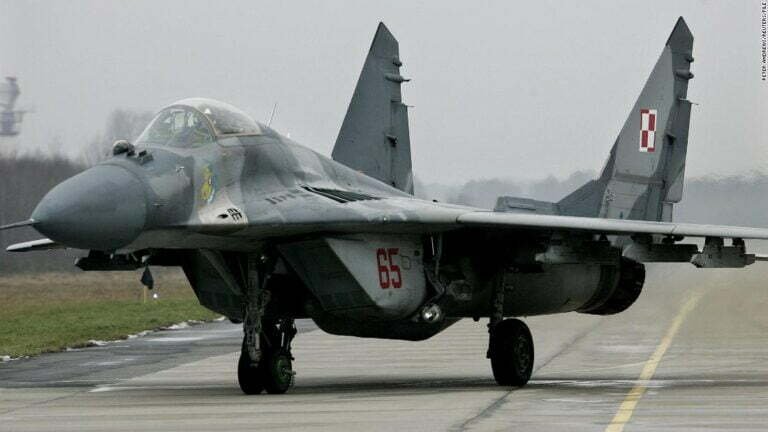London (CNN) In one of the most significant increases in military support to Ukraine from a NATO member since the Russian invasion, Polish President Andrzej Duda on Thursday became the first leader from the security alliance to pledge fighters jet to Kyiv.
Duda announced that four MiG-29 fighters will be delivered to Ukraine in the coming days — the rest, he said, are being serviced and will likely be delivered one after the other. Four may be a small number, but it is a big step from a year ago, when a NATO member sending such sophisticated lethal support to Ukraine was politically unthinkable.
It is not surprising that this step was taken by Poland — a country with a pronounced concern over Russian expansion fueled by deep historical experience of Russian aggression.
Will it make a difference? On a political level, it can. By normalizing such support, it could start a domino effect where many European countries continue to provide fighter jets to Ukraine.
Less than a day after Poland’s pledge, Slovakia’s Prime Minister Eduard Heger announced that his government would send a fleet of 13 MiG fighter jets to support Ukraine’s defense. It is likely that many European countries will follow suit, and release their Soviet-designed MiGs as they modernize their own air forces.
This is exactly what Poland is doing. Last year the country signed a massive $14.5 billion defense deal with South Korea that included the purchase of 48 FA-50 light aircraft, and it also added American F-35 Lighting II stealth fighters to its fleet. Another practical advantage is that since many European countries have MIG-29, their parts are more readily available for repair and maintenance of Ukrainian aircraft.
On the question of a military advantage, the Kremlin is predictably indifferent, claiming that the gift of many Soviet-era MiGs to Ukraine will not change the course of the conflict. Which is probably why F-16s – and not MiGs – are actually at the top of President Volodymyr Zelensky’s wish list.
For obvious reasons, the exact makeup of Ukraine’s air force, which is probably about a tenth the size of Russia’s, remains shrouded in secrecy. Ukraine inherited several Soviet-made MiG-29 planes after the collapse of the Soviet Union in 1991, about five years after they entered service. But its fleet was hit after Russia illegally annexed Crimea.
MiG-29s are analog aircraft, using old flight technology. Zelensky’s F-16s are digital. MiGs can be used for short combat missions, they can deploy weapons and shoot down Russian aircraft with good maneuverability at short range. But F-16s can fly longer, are more versatile, have integrated weapons systems and have better long range and radar capabilities, thus providing better early warning.
Ukrainian President Volodymyr Zelensky has requested F-16 fighter jets.
Defense analyst Alex Walmsley, a fellow at the Royal United Services Institute (RUSI) in London, uses the analogy of comparing a “1990s laptop to the latest MacBook. Or a Ford Escort and a Porsche. They basically do the same things — fly and launch missiles — but the MIGs aren’t as responsive or powerful.”
The US has so far resisted calls to provide F-16s to Ukraine on the grounds of avoiding escalation with Russia, as well as impracticality. The desire to avoid a cataclysmic spill-over of the conflict is top of mind this week after the downing of a $32 million US Reaper drone over the Black Sea by a Russian jet – the first moment when the Russian and American planes are in direct contact. since the war started. The potentially incendiary incident was seized upon by Russia as proof of direct American involvement in the conflict.
Still, the shift from resistance to delivery has already happened; the US went around supplying Ukraine with M1 Abrams tanks after Germany reversed its own policy on Leopard II tanks.
But the impractical argument is not just a political fig leaf. The Ukrainian Air Force already operates MiG jets so they can use them as soon as they arrive, while it takes months to train a MiG-29 pilot to the high level of comfort and efficiency of a F -16. Not to mention that pilots are in short supply in Ukraine.
Retired US Lieutenant General Mark Hertling says that while the Ukrainians can easily adapt to new kit such as user-friendly Himars and Javelins, the F-16 is a “complete which is a different ball game.” They have different engine parts, design and fire control systems for shooting and dropping bombs. “A lot of people want things to happen in Ukraine now,” Hertling said, “but without years of peacetime training and establishing continuity and healing, you’re not going to get those result you think you will get.”
The initial pledges of the jets would increase Ukraine’s air defense, but in no way decisively change or provide an edge for Ukraine in the conflict. Former RAF F-16 Fighter Pilot William Gilpin told CNN: “There’s a saying — if you’re a generation behind, there’s no point going back. Right now the Ukrainian Air Force is a generation behind the Russians . The F-16s could move them a generation ahead.”
This is the dilemma. The impracticality of supplying Ukraine with F-16 jets, which require a huge training burden in the midst of an active conflict, is clear. But without them, gaining air superiority is even more out of reach.
